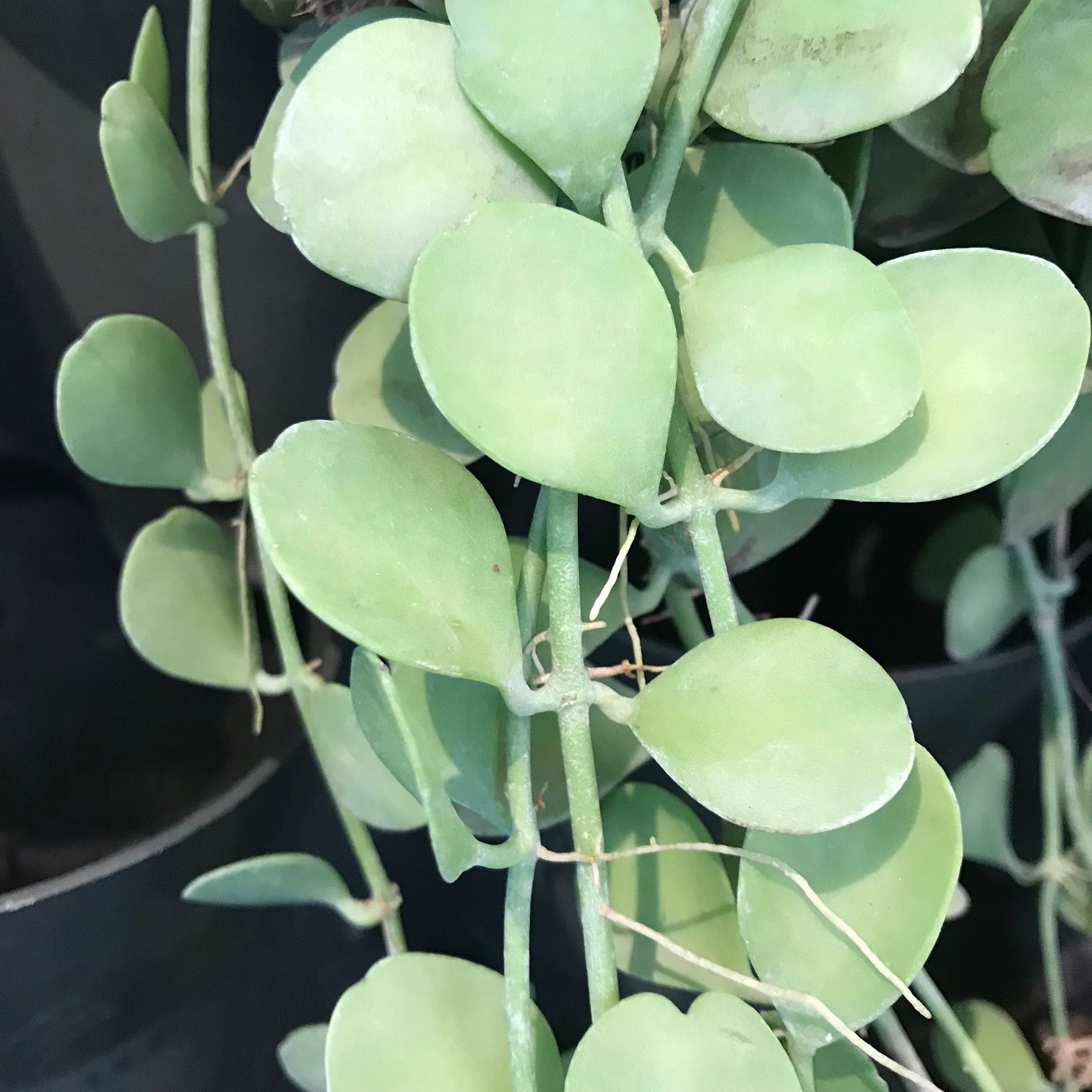
Dischidia nummularia - String of Nickels
Contents
- Top Tips
- Location, Water, Humidity & Fertilisation
- Common Issues
- Origins, Temperature, Propagation, Repotting & Toxicity.
Need the answer to a specific plant query? Book a 1-to-1 video call with THE HOUSEPLANT DOCTOR™, the website's friendly author, to overcome and address your niggling problem! Available on iMessage, WhatsApp, Facebook Messenger & more.
Top Tips & Info
- Care Difficulty - Easy
- Provide a bright location with a splash of morning or evening sunlight for quality growth.
- Allow the soil's top half to dry in between waters, reducing this slightly further in the autumn and winter. If yours is grown in Sphagnum Moss, allow it to become almost dry in between submersions to avoid the risk of rot.
- A good level of humidity and air circulation is crucial for a long-lasting specimen. Be sure to introduce a pebble tray (if grown in soil & a pot), or in a humid location like a bathroom or nearby sink for those with Sphagnum.
- Fertilise using a 'Houseplant' labelled feed every four waters in the spring and summer, reducing this to every six in the colder months.
- Dischidia won't need frequent repotting, so once every two or three years is best to avoid transplant shock. Those in Sphagnum may need a refreshment of new Moss every twelve to eighteen months, due to depreciation of quality.
- Pests aren't usually an issue; however, keep an eye out for Mealybugs & Scale.
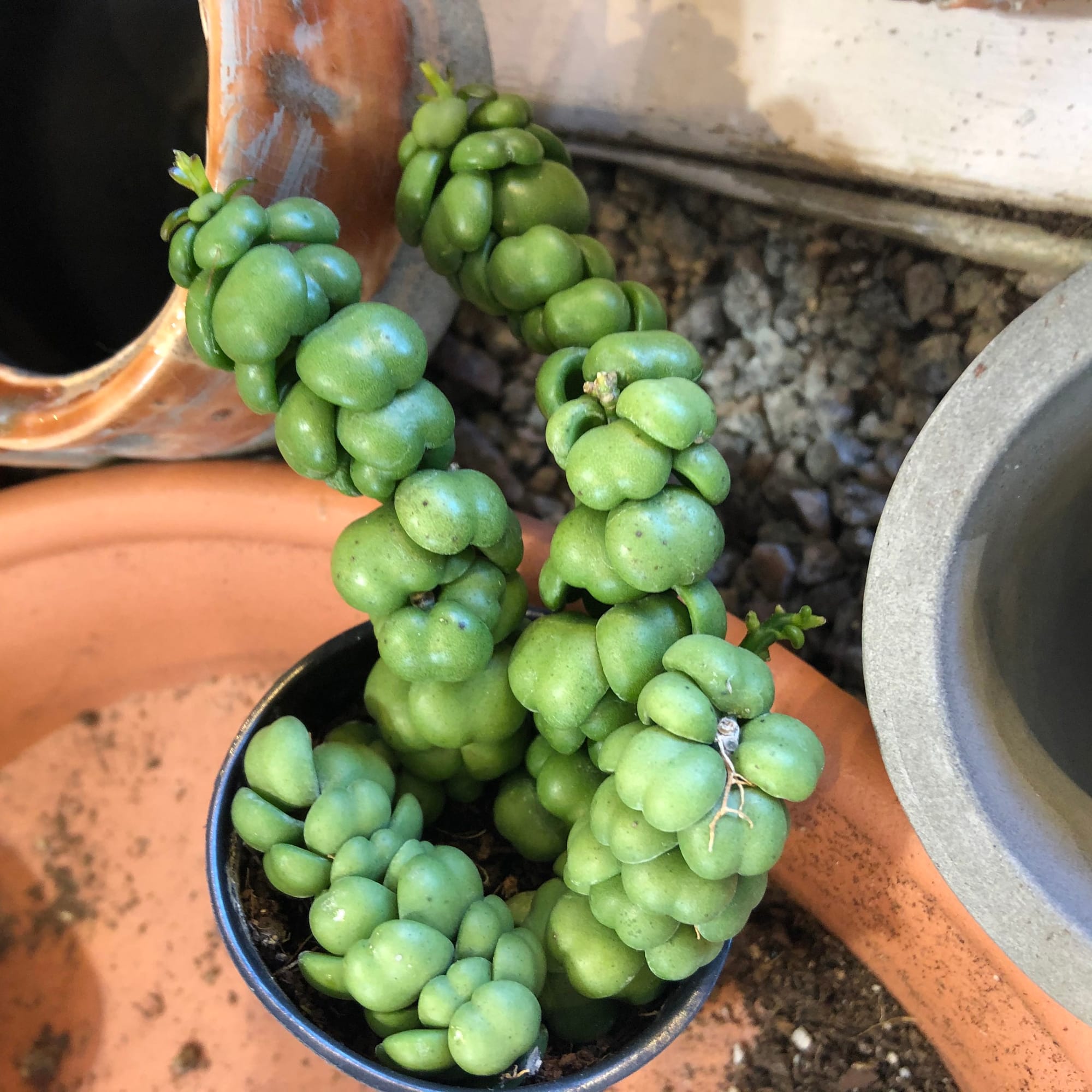 Dischidia nummularifolia 'Dragon Jade'
Dischidia nummularifolia 'Dragon Jade'
Location & Light - 🔸🔸🔸
A minimal amount of morning or evening sunlight is fantastic for Dischida. Specimens kept on a shelf where the soil line isn't in view of the natural light must follow the rule of 'near-drenches between droughts'. We'd recommend a windowsill, or nearby table is the perfect location for this plant, as a lack of natural light penetrating the soil's face may result in overly soggy soil. Bright, indirect location is still advised; however, you must keep on the drier side to avoid over-watering from its moisture-retentive leaves.
Water - 🔸
Soil - Those kept in the traditional pots must have the soil's top half to dry in between waters. To confirm that your specimen needs a water, feel the weight of the pot and if it still feels heavy, allow the pot to become slightly lighter before another hydration. It's always better to under-water Dischidia than over-do it, so if you're unsure as to when it needs a drink, leave it for another few days!
Sphagnum Moss - Always keep in mind the wet-dry cycle of caring for plants in Moss. It's highly detrimental to maintain moist or soggy Sphagnum for long periods, as it'll begin to rot and mush-away. Submerge the Moss (along with the plant) into a container of lukewarm tap water for five minutes once the Sphagnum feels dry to the touch.
Humidity -🔸🔸
Create a pebble tray to provide a moist and stable environment for your plant. If the surrounding saturation is too low or the heat too high, its juvenile leaves may start to brown over and curl, especially in direct sunlight. Gently hose the foliage down from time to time to hydrate the leaves and keep the dust levels down.
For those who have theirs in Moss, the Sphagnum will provide a reliable level of localised humidity, so a tray is not wholly needed.
Fertilisation - 🔸
Fertilise every four waters during the growing period before reducing this to every six in the autumn & winter. Although an 'All-Purpose' fertiliser will still do the job, we'd recommend using a specific 'Houseplant' labelled fertiliser as it'll support the vital thirteen nutrients that this species will need to grow.
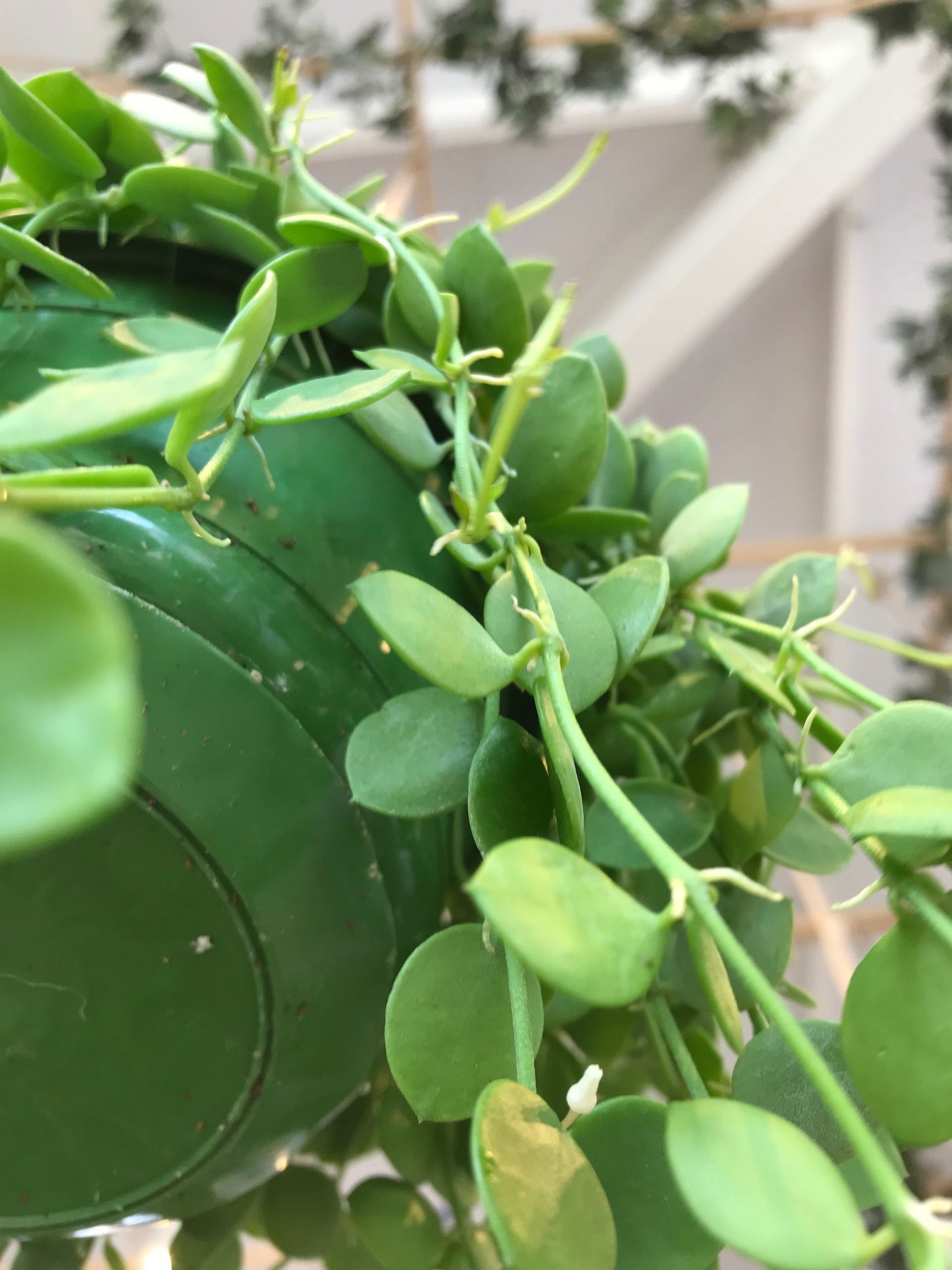 Dischidia can be propagated by vine cuttings; scroll down to 'Propagation' to learn more about this process...
Dischidia can be propagated by vine cuttings; scroll down to 'Propagation' to learn more about this process...
Common Issues with Dischidia
Root or leaf rot is a common issue among specimens sat in too dark environments with prolonged soil moisture. Symptoms include yellow or rotten leaves, mouldy soil/Moss, stunted growth and a rotten base resting against the soil or Moss. Take the plant out of the pot and inspect health below the compost line. If the roots sport a yellow tinge, you're good to go, but if they're brown and mushy, action must be taken immediately. More information about addressing root rot can be found on this link.
A lack of leaves on the soil's top could be the product of excess moisture settling on the foliage. Although watering from the top is best, it's recommended to use the bottom-up method if you're a messy waterer. For specimens that have a bare head, improve growing conditions by using this method and increasing the light levels and air circulation. Take vine cuttings to promote a bushier appearance above the soil line - scroll down to 'Propagation' for more information. Finally, always remove yellowed or rotten debris from the soil as it could harbour both bacterial and fungal diseases, which will continue the plant's decline.
Lower leaf-loss is a common and significant issue among gardeners. This unfortunate phenomenon could be a product of several different problems, most notably being dark locations, water-related abuse or environmental shock. Introduce the plant to a more well-lit area with a splash of off-peak sunlight; if caught in time, the leaf-loss should stop within a few weeks. If you feel that you're watering habits aren't up to scratch, familiarise yourself with our care tips provided at the top of this article. It's always best to under-water an indoor Dischidia than over-do it, purely on its poor ability to endure continued sogginess. The final culprit could be down to a sudden relocation; if you've recently purchased the specimen within the last six weeks, the chances are it is still acclimatising to the new environment. Although this shouldn't happen, a vastly different setting will cause sudden foliage-loss and stunted growth. You'll have two options of either waiting it out or presenting a more Dischidia-friendly environment, mentioned in the 'Location & Light' section. We would fertilise the plant the next time it needs water, using a 'Houseplant' labelled feed. If the leaf-loss persists, take stem cuttings of at least three nodes to ensure the specimen's existence continues; scroll down to 'Propagation' for more information on this.
Rotten or declining Sphagnum Moss is a common issue among growers. Although it's normal for the Sphagnum to depreciate with time, over-watering and/or a too shady location may speed up this process. Keep the medium on the drier side along with improving the air circulation. If the whole Moss has become rotten, scroll down to 'Repotting' for more information!
Too much sunlight will lead to sun scorch, with typical signs including browning or crispy leaves, dry leaf-edges, sunken leaves or stunted growth. Although too little light will cause over-watering issues, excess sunlight will be a detriment to the plant as well. If yours has fallen short of this, reduce the amount of the sun considerably and always be mindful of environmental shock (when two locations offer too different growing conditions). Remove some of the affected leaves and increase waters slightly.
Powdery Mildew and Southern Blight are major threats among heavy foliage plants when excess moisture is allowed to sit on compacted foliage. Remove the affected areas and improve the growing conditions by situating the plant in a brighter location and keeping the leaves dry.
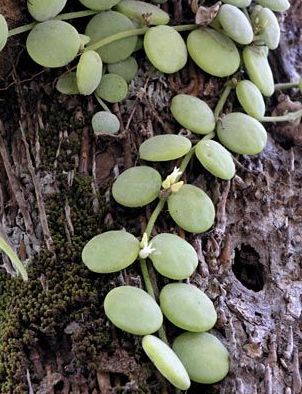 The String of Nickels is an epiphytic species that naturally grow along bark and trees in South-East Asian rainforests. Copyright: ANPSA
The String of Nickels is an epiphytic species that naturally grow along bark and trees in South-East Asian rainforests. Copyright: ANPSA
Origins
Dischidia was first penned by Robert Brown in 1810, using the Greek word, dischides, to refer to the 'parted' or 'cleated' crowns. Others, however, feel that it acknowledges the Greek words dis and kichon ('two' and 'covering coat') that refers to the type species' appearance (Dischidia nummularia). The specific epithet of 'nummularia' can be translated from the Greek word for 'coin'. Dischidia, like Hoya, are part of the Apocynaceae family, offering similar characteristics in both appearance and natural distributions.
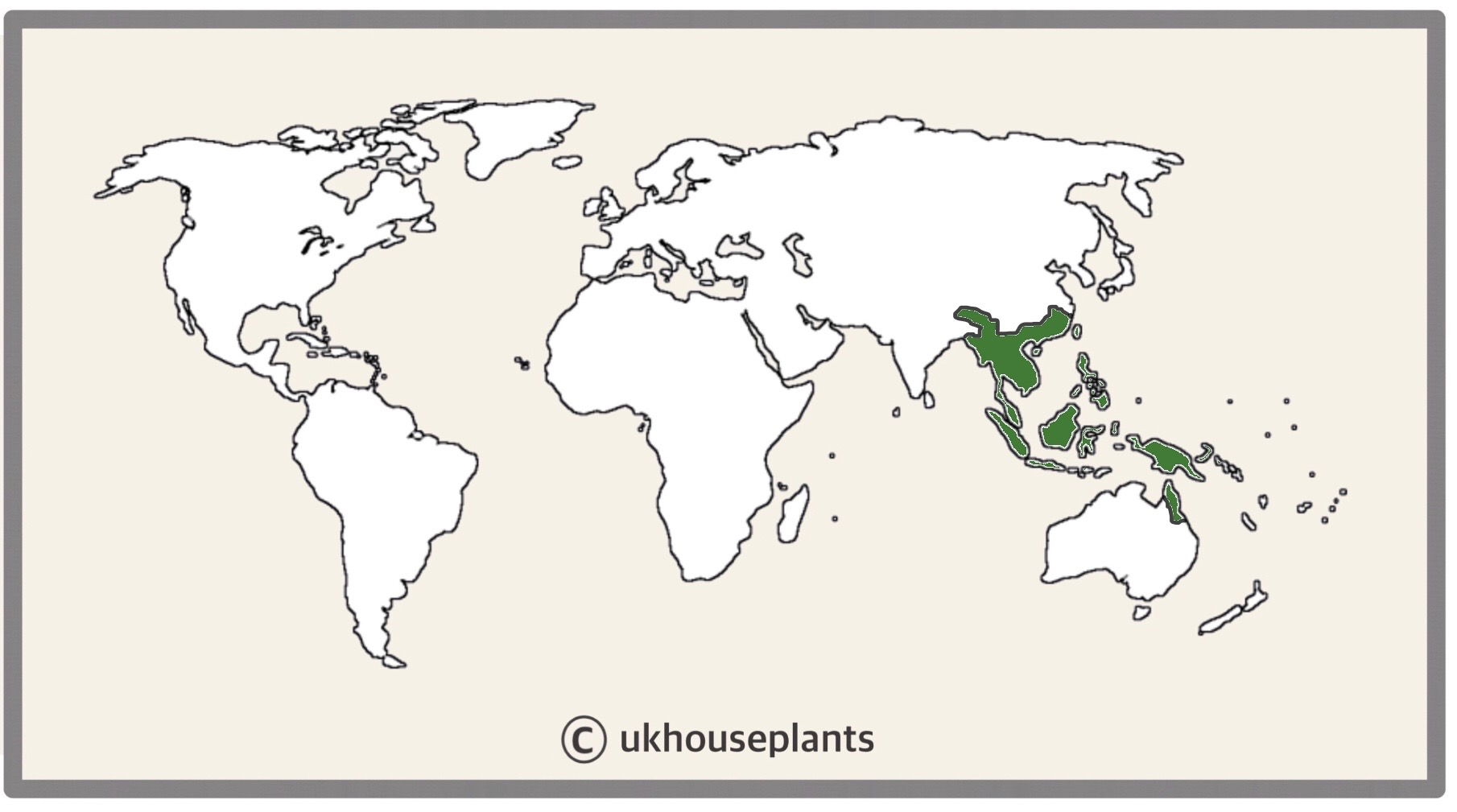 The Distribution of Dischidia.
The Distribution of Dischidia.
Temperature
12° - 30°C (50° - 86°F)
H1b (Hardiness Zone 12) - Can be grown outdoors during the summer in a sheltered location with temperatures above 12℃ (54℉), but is better to remain indoors, too. If you decide to bring this plant outdoors, don't allow it to endure any direct sunlight as it may result in sun-scorch and dehydration. Regularly keep an eye out for pests, especially when re-introducing it back indoors.
Spread
Up to 1m in vine length and 0.3m in width, with the ultimate height being reached in 5 - 8 years. Expect around 5 - 10cm (2 - 3.5 inches) of new growth per season.
Pruning & Maintenance
Remove yellow or dying leaves, and plant debris to encourage better-growing conditions. While pruning, always use clean utensils or shears to reduce the chance of bacterial and fungal diseases. Never cut through yellowed tissue as this may cause further damage in the likes of diseases or bacterial infections. Remember to make clean incisions as too-damaged wounds may shock the plant, causing weakened growth and a decline in health.
Propagation
Via Seed or Vine Cuttings.
Vine Cuttings
- Choose the healthiest, most established vines from the leading growths. This propagation method can be taken from spring to summer, using two nodes
- Cut directly below a node (leaf) at the vine's terminal, using a clean pair of scissors to reduce bacteria count.
- Place the cutting into water, and once small roots develop in the nodal junctions (3cm / 1 inch), which can take up to 30 days, it's time to prepare the soil and pot.
- Use a 7cm (2.7 inches) pot that has good drainage holes - plastic or terracotta are both acceptable in this instance. 'Houseplant' labelled composts are best as they'll provide adequate drainage and airflow around the roots. Alternatively, place the cutting back into the soil of the mother plant to promote a bushier appearance, as mentioned in 'Common Issues'.
- Set the cutting into the compost, keeping the foliage above the soil line. Be sure to submerge the bottom nodes into the soil, or else further root development will hinder. Try not to over-pot the cuttings - blackleg occurs when the bottom wound becomes infected, typically caused by water-logging with too little light.
- Avoid direct sunlight and maintain moist soil to prevent dehydration. After a twelve-week period in the soil, treat the specimen as a mature plant by following the care advice penned above.
Flowers
Dischidia will produce small clusters of white flowers along the vines' nodes, lasting up to a week once opened. To aid the chance of a summer bloom, reduce the amount of waters considerably, and dip the nighttime temperatures to around 15⁰C (64⁰F) in the previous winter months. The combination of drying soil, shorter days and cold nights will give the plant a dormancy period, which is vital for flower growth in the following season.
Repotting
Repot every two or three years in the spring, using a 'Cactus & Succulent' labelled potting mix and the next sized pot with adequate drainage. Dischidia are far better potbound for several years due to the heightened risk of root rot and repotting-issues (like transplant shock), so only repot if you feel it's wholly necessary - restricted root growth will also increase the chance of blooms, too.
Hydrate the plant 24hrs before tinkering with the roots to prevent the risk of transplant shock. For those situated in a darker location, introduce an extra amount of perlite and grit into the deeper portion of the pot to downplay over-watering risks. Click on this link for a detailed step-by-step guide on transplantation, or via this link to learn about repotting with root rot.
Book a 1-to-1 video call with Joe Bagley if you'd like a personal guide to repotting your houseplant. This will include recommending the right branded-compost and pot size, followed by a live video call whilst you transplant the specimen for step-by-step guidance and answer any further questions!
Pests & Diseases
Keep an eye out for spider mites, mealybugs, whitefly, root mealybugs, scale & thrips. Typical diseases associated with this genus are leaf-spot disease, botrytis, powdery mildew & root rot. Click here for more information about how to identify and address any of these issues.
Toxicity
This plant is classified as poisonous. If parts of the plants are eaten, vomiting, nausea and a loss of appetite could occur. Consumption of large quantities must be dealt with quickly; acquire medical assistance for further information. Its sap may cause irritation on the skin of sensitive people.
Retail Locations
Online Stores.
Book a 1-to-1 Call with THE HOUSEPLANT DOCTOR™
If you need further advice with your houseplants, book an advice call with ukhouseplants' friendly and expert writer today! This can be done via a video or audio call on most apps, including Facebook, FaceTime & Skype. A ten-minute call costs £5.99 (US$7), or £15.99 for thirty minutes. You can ask multiple questions, including queries on plants, pests, terrariums, repotting advice and anything in between. Please consider supporting this service to keep ukhouseplants thriving!